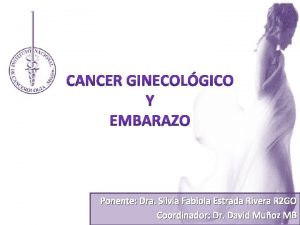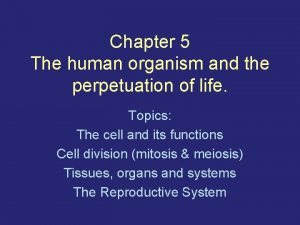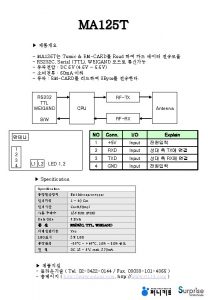The Perpetuation of Life Chapter 5 pages 125
























































- Slides: 56

The Perpetuation of Life: Chapter 5 pages 125 -157

Why bother reproducing sexually when asexual reproduction can generate new individuals? Asexual reproducers make identical copies of themselves whereas sexual reproducers make new individuals that are different. In a changing environment, creating varied offspring can make the difference between survival or extinction.

Reproduction The process by which organisms make more organisms like themselves In the human reproductive process, two kinds of gametes (sex cells) are involved. The male gamete = sperm The female gamete = ovum These two gametes meet in the female reproductive system in order to create a new individual.

Puberty voccurs during adolescence usually between the ages of 10 -14 vcharacterized by the changes that prepare the human body for the ability to reproduce vbeginning is marked by a progressive increase in the production of sex hormones

Hormones: va chemical substance, produced by a specialized organ called a gland vwhen released into the bloodstream they stimulate the activity of specific organs or tissues vonly organs that are sensitive to the specific hormones are affected by their presence in the bloodstream

Puberty hormones: Puberty is stimulated by the release of 2 hormones that are secreted by the pituitary gland ( a small grape sized gland located at the base of the brain) FSH and LH.

FSH= follicle stimulating hormone LH= luteinizing hormone In females: • responsible for the maturation of ova • stimulate the ovaries to produce female sex hormones estrogens and progesterone In males: • the production of spermatozoa ( mature sperm cells) • stimulate the testicles to produce male sex hormones primarily testosterone

The production of these hormones initiates significant physical and psychological changes = primary and secondary sexual characteristics Refer to page 142 -143 and copy diagram 5. 22 into your notes. Then list the primary and secondary sexual characteristics in females and males.

ACNE: http: //www. 5 min. com/Video/Lear n-about-Causes-of-Acne 286302795

The Female Reproductive System v Unlike the male, the human female has a reproductive system located entirely in the pelvis. WHY

External Structures Purpose of these external parts: • enable sperm to enter the body • protect the internal genital organs from infectious organisms Structures: vlabia (which means lips) : two pairs of skin flaps that surround the vaginal opening. These are known as the labia majora and the labia minora.

External Structures Continued. . . • The clitoris, a small sensory organ, is located toward the front of the vulva where the folds of the labia join.

Internal Reproductive Organs A female's internal reproductive organs are responsible for : • the creation and transport of the ova for fertilization • conception ( the fertilization of an egg by a sperm) which occurs in the fallopian tubes • growth and development of a fetus if fertilization occurs • the production of female sex hormones • menstruation ( if fertilization does not occur)

v Between the labia are openings to the urethra (the canal that carries urine from the bladder to the outside of the body) and vagina.

Internal Structures Vagina: a muscular, hollow tube that extends from the vaginal opening to the uterus. Also known as the birth canal. • muscular walls allow it to expand contract. • it connects with the uterus, or womb, at the cervix (which means neck) • the cervix has strong, thick walls with an opening no wider than a straw



Internal Reproductive Organs cont v At the upper corners of the uterus, the fallopian tubes connect the uterus to the ovaries. v. Ovaries : 2 oval-shaped organs that lie to the upper right and left of the uterus. They produce, store, and release eggs into the fallopian tubes in the process called ovulation. v Each ovary measures about 1 1/2 to 2 inches (4 to 5 centimeters) in a grown woman.

The human egg has been filmed in close-up emerging from the ovary for the first time, captured by chance during a routine operation

Internal Reproductive Organs cont. . . Fimbria (plural, fimbriae): a fringe of tissue around the fallopian tube directed towards the ovary Purpose? An ovary is not directly connected to its adjacent Fallopian tube. When ovulation is about to occur, the sex hormones activate the fimbriae, causing it to swell with blood and hit the ovary in a gentle, sweeping motion. When an ovum is released from the ovary the fimbriae sweep it into the Fallopian tube

Fimbriae

Internal Reproductive Organs cont Fallopian tubes: • 2 narrow tubes each attached to a side of the uterus • they are about 4 inches (10 centimetres) long and about as wide as a piece of spaghetti • serve as tunnels for the ova (egg cells) to travel from the ovaries to the uterus with the help of tiny hairs in the tube's lining that help push it down the narrow passageway toward the uterus. • conception normally occurs here

Fallopian tubes

Internal Reproductive Organs cont. . . Uterus (womb): • a hollow, pear-shaped organ that is the home to a developing fetus • it is divided into two parts: • the cervix: the lower part that opens into the vagina; a channel through the cervix allows sperm to enter and menstrual blood to exit. • the corpus : the main body of the uterus, which can easily expand to hold a developing baby

Ø The uterus contains some of the strongest muscles in the female body. These muscles are able to expand contract to accommodate a growing fetus and then help push the baby out during labor.


Commercial http: //www. youtube. co m/watch? v=lpype. LL 1 d As&feature=related

The Menstrual Cycle During puberty, hormones are released from the brain that stimulate the ovaries. The ovaries then produce estrogen and progesterone. These are hormones that cause the eggs in the ovaries to mature so the woman can become pregnant when she chooses to.

Every month, one egg leaves one of the ovaries on its way to the uterus via the fallopian tubes. http: //www. youtube. com/watch? v=n. Lmg 4 w. SHdx. Q In preparation for the egg, the uterus starts to develop a thicker lining and it’s walls become cushiony (the endometrial lining). The endometrial lining is tissue lining the uterine cavity that grows during the menstrual cycle in preparation for nurturing an embryo.

If the egg reaches the uterus and is fertilized by a sperm cell, it attaches to this cushiony wall. Most of the time the egg just passes right through without fertilization. Since the uterus no longer needs the extra blood and tissue which made up the thick walls, it sheds them by way of the vagina. This cycle will happen nearly every month until the ovaries stop releasing eggs, usually several decades later. (Menopause).

FACTS Periods are different for every woman. Some girls start menstruation when they're 9 or 10; some in their late teens. The length of the cycle also varies. Some periods last longer than 28 days, some shorter.


Menstrual cramps are pretty common during the first few days of your period. These are most likely caused by prostagladins. Prostaglandins cause the muscles of the uterus to contract. When the uterine muscles contract, they constrict the blood supply (vasoconstriction) to the endometrium.

This contraction blocks the delivery of oxygen to the tissue of the endometrium which, in turn, breaks down and dies. Menstrual cramps of some degree affect more than an estimated 50% of women, and among these, up to 15% would describe their menstrual cramps as severe. After the death of this tissue, the uterine contractions literally squeeze the old endometrial tissue through the cervix and out of the body by way of the vagina.

The Menstrual Cycle Copyright 2009 – Alberta Health Services – www. teachingsexualhealth. ca


Some symptoms of PMS include: • acne • Swollen or tender breasts • Feeling tired • Trouble sleeping • Upset stomach, bloating, constipation, or diarrhea • Headache or backache • Appetite changes or food cravings • Joint or muscle pain • Trouble with concentration or memory • Tension, irritability, mood swings, or crying spells • Anxiety or depression Symptoms vary from woman to woman.

The difference between menstrual cramps that are more painful and those that are less painful is apparently related to a woman's prostaglandin levels. Hormone levels rise and fall during a menstrual cycle, affecting the way a female feels both mentally and physically. Emotions can become more intense than usual, and many women may feel bloated because of water retention. When your period begins, PMS usually goes away. You may also have acne flare-ups.

If you have just begun your menstruation, your body will need time to regulate itself to these changes. Your periods might be a bit erratic at first. You may have two cycles in one month and miss having one the next month. How long your period lasts also varies. Some girls have their periods for only 3 or 4 days, others as long as a week. The menstrual flow of blood can vary from woman to woman also.

Menopause

Menopause: • A natural physical change that occurs in women 40+ • Signals the end of the fertile phase of a woman’s life • ovarian and menstrual cycles come to an end • as ovaries stop producing estrogens the woman will feel discomfort such as hot flashes, mood swings and bone loss

Male reproductive system The reproductive system comprises of reproductive organs. In the male: the organs include the testes, accessory ducts, accessory glands, and penis.

• Sperm cells are produced within the testes, which are located within the scrotum. The testes are paired reproductive organs in the scrotum, which hangs outside the human body. Normal sperm production requires the cooler outside temperature.

Each testis contains coiled seminiferous tubules where sperm (male reproductive cells) production occurs. Seminiferous tubules are located in the testicles, and are the specific location of meiosis, and the subsequent creation of gametes, namely spermatozoa.

Two hormones released by the pituitary gland regulate the functioning of the testes (LH) – Luteinizing hormone • Stimulates the secretion of testosterone (FSH) - Follicle-stimulating hormone • FSH along with testosterone stimulates sperm production

• Sperm mature as they travel through the network of tubules that make up the testes and then reach the epididymis. • The epididymis is a set of coiled tubes (one for each testicle) that connects to the vas deferens, also found in the scrotum. • Within the epididymis, the sperm acquire the ability to “swim” and are stored here until they are expelled.

The vas deferens: is a muscular tube that passes upward alongside the testicles and transports the sperm-containing fluid called semen. Semen is the fluid that is released through the penis during orgasm. Semen is made up of sperm from the testicles and fluid from the prostate and other sex glands.

• As sperm moves through the urethra, they mix with the fluid secreted by the accessory glands, including the seminal vesicles and the prostate gland, which provide fluids that lubricate the duct system and nourish the sperm. Bulbourethral gland – releases fluid before semen leaves the body to neutralize acids in the urethra ( cleaning crew) The seminal vesicles are sac-like structures attached to the vas deferens to the side of the bladder. They produce a fluid that is rich in sugar that the sperm use for energy The prostate gland, which produces some of the parts of semen, surrounds the ejaculatory ducts at the base of the urethra, just below the bladder. This gland releases an alkaline fluid that neutralizes the acids in the female reproductive tract

An ejaculation ejection of sperm from the penis has 300 to 500 million sperm.

Each sperm cell has three parts: 1. A head 2. Middle piece 3. A tail An acrosome at the head tip produces enzymes that help penetrate the female ovum (egg). Draw the sperm.

Some fun clips http: //www. youtube. com/watch? v=OX 1 XAm. Dp Kqo Homer explains how Maggie was created. What’s wrong with this slide? ( How many sperm get all the way to the fallopian tubes? ) http: //www. youtube. com/watch? v=TJs. QAV 6 F 8 1 w Stewie meets his could be bother. . they have similar traits…sperm carry genetic info and fight a battle to get to the egg.

Fertilization- the union of the gametes

Fertilization aka Conception

Sexual reproducers must be able to make sex cells (gametes) Sex cells have mixed up DNA – not identical to the parent Since 2 different sex cells unite to make a normal cell, the # of chromosomes has to be reduced by half. A process called meiosis accomplishes this feat. Meiosis only happens in testes and ovaries. Human cells have 23 PAIRS of chromosomes (1 chromosome from each parent). Mitosis makes cells with the same 23 pairs (diploid).

Meiosis makes cells with only 23 chromosomes (haploid) and the chromosome pairs shuffle their DNA so each cell made has a different combination of DNA.

Mitosis Happens all over body & in somatic cells Makes identical cells. Makes diploid cells. Makes cells with pairs of chromosomes. Happens from birth to death. Is needed for individual survival Meiosis Happens only in testes and ovaries. Makes different cells. Makes haploid cells. Makes cells with single chromosomes. Happens only after sexual maturity. Is not needed for individual survival.
 Printed pages vs web pages
Printed pages vs web pages Iodine 125 half life
Iodine 125 half life Jsf sample
Jsf sample Hát kết hợp bộ gõ cơ thể
Hát kết hợp bộ gõ cơ thể Lp html
Lp html Bổ thể
Bổ thể Tỉ lệ cơ thể trẻ em
Tỉ lệ cơ thể trẻ em Voi kéo gỗ như thế nào
Voi kéo gỗ như thế nào Thang điểm glasgow
Thang điểm glasgow Hát lên người ơi
Hát lên người ơi Môn thể thao bắt đầu bằng chữ f
Môn thể thao bắt đầu bằng chữ f Thế nào là hệ số cao nhất
Thế nào là hệ số cao nhất Các châu lục và đại dương trên thế giới
Các châu lục và đại dương trên thế giới Công thức tiính động năng
Công thức tiính động năng Trời xanh đây là của chúng ta thể thơ
Trời xanh đây là của chúng ta thể thơ Mật thư anh em như thể tay chân
Mật thư anh em như thể tay chân Phép trừ bù
Phép trừ bù độ dài liên kết
độ dài liên kết Các châu lục và đại dương trên thế giới
Các châu lục và đại dương trên thế giới Thể thơ truyền thống
Thể thơ truyền thống Quá trình desamine hóa có thể tạo ra
Quá trình desamine hóa có thể tạo ra Một số thể thơ truyền thống
Một số thể thơ truyền thống Cái miệng xinh xinh thế chỉ nói điều hay thôi
Cái miệng xinh xinh thế chỉ nói điều hay thôi Vẽ hình chiếu vuông góc của vật thể sau
Vẽ hình chiếu vuông góc của vật thể sau Biện pháp chống mỏi cơ
Biện pháp chống mỏi cơ đặc điểm cơ thể của người tối cổ
đặc điểm cơ thể của người tối cổ Thế nào là giọng cùng tên?
Thế nào là giọng cùng tên? Vẽ hình chiếu đứng bằng cạnh của vật thể
Vẽ hình chiếu đứng bằng cạnh của vật thể Vẽ hình chiếu vuông góc của vật thể sau
Vẽ hình chiếu vuông góc của vật thể sau Thẻ vin
Thẻ vin đại từ thay thế
đại từ thay thế điện thế nghỉ
điện thế nghỉ Tư thế ngồi viết
Tư thế ngồi viết Diễn thế sinh thái là
Diễn thế sinh thái là Dạng đột biến một nhiễm là
Dạng đột biến một nhiễm là Số.nguyên tố
Số.nguyên tố Tư thế ngồi viết
Tư thế ngồi viết Lời thề hippocrates
Lời thề hippocrates Thiếu nhi thế giới liên hoan
Thiếu nhi thế giới liên hoan ưu thế lai là gì
ưu thế lai là gì Hổ sinh sản vào mùa nào
Hổ sinh sản vào mùa nào Khi nào hổ con có thể sống độc lập
Khi nào hổ con có thể sống độc lập Sơ đồ cơ thể người
Sơ đồ cơ thể người Từ ngữ thể hiện lòng nhân hậu
Từ ngữ thể hiện lòng nhân hậu Thế nào là mạng điện lắp đặt kiểu nổi
Thế nào là mạng điện lắp đặt kiểu nổi 30'u 60 olan bir sayının 75 fazlası kaç olur
30'u 60 olan bir sayının 75 fazlası kaç olur Ca 125 valores normales
Ca 125 valores normales 125+35
125+35 Conversion entier signé non signé
Conversion entier signé non signé Valores normales de ca 125
Valores normales de ca 125 Ca 125
Ca 125 Square root 1 to 100
Square root 1 to 100 Acp 125 g
Acp 125 g Cone volume ratio
Cone volume ratio Diaphyllin köhögésre
Diaphyllin köhögésre Inclination of top view length with xy line is given by
Inclination of top view length with xy line is given by Ao 125
Ao 125
















































































